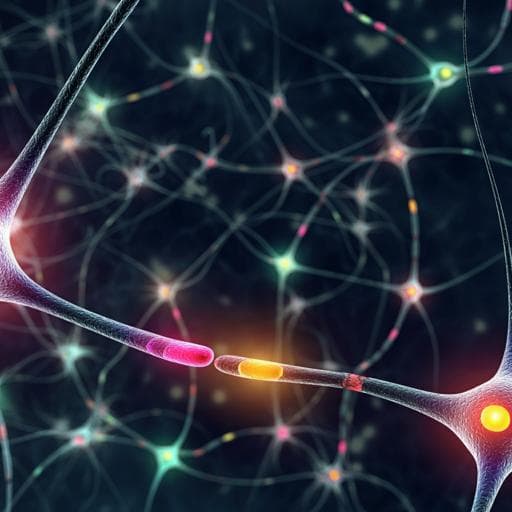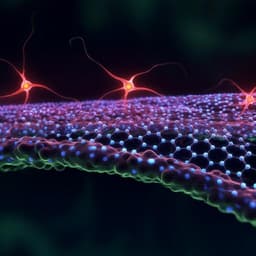
Biology
A genetically encoded tool for reconstituting synthetic modulatory neurotransmission and reconnect neural circuits in vivo
J. D. Hawk, E. M. Wisdom, et al.
Discover the groundbreaking HySyn system developed by researchers Josh D Hawk, Elias M Wisdom, Titas Sengupta, Zane D Kashlan, and Daniel A Colón-Ramos. This innovative approach enables the manipulation of synaptic relationships in vivo, effectively rewiring behavioral circuits in mammalian culture and *C. elegans*. Delve into the potential of HySyn to enhance our understanding of synaptic transmission and neuropeptide signaling.
~3 min • Beginner • English
Introduction
Neural circuit interrogation tools typically modulate activity in pre-existing synapses, but do not allow creation of new, specific synaptic-like relationships to rewrite circuit logic. The authors hypothesized that an orthogonal neuropeptide–receptor pair from Hydra could be engineered to harness conserved neuropeptide processing and calcium signaling to form synthetic, modulatory connections between genetically specified cells. The goal was to create HySyn, a modular and orthogonal system capable of reconnecting or reconfiguring neural circuits in vitro and in vivo, enabling causal tests of neuromodulatory influence on circuit function and behavior.
Literature Review
Prior work established powerful chemogenetic (e.g., DREADDs) and optogenetic approaches to manipulate neuronal activity and map connectivity, as well as strategies to label or insert synapses (e.g., trans-synaptic fluorescence complementation, insertion of ectopic electrical synapses in C. elegans). However, there remained a need for tools that can rationally construct new, selective neuromodulatory (volume transmission) connections independent of native synaptic architecture. Neuropeptide signaling mechanisms and processing are evolutionarily conserved, suggesting feasibility for heterologous reconstitution using orthogonal peptide–receptor pairs.
Methodology
- System design: HySyn comprises a Hydra-derived Ramide-related neuropeptide (HyRamide) and its cognate receptor (HyCal/HyRac), chosen for sequence divergence from other organisms and specificity, yet leveraging conserved neuropeptide processing and calcium signaling.
- Synthetic pre-pro-peptide carrier (HyPep): Engineered a pre-pro-peptide scaffold to drive heterologous expression, processing, and trafficking via endogenous neuropeptide pathways. HyPep includes an N-terminal signal peptide (based on neuropeptide Y), acidic spacers with dibasic endopeptidase (e.g., PC2) consensus cleavage sites, and the heterologous Hydra neuropeptide sequence.
- In vitro validation in mammalian cells: Transfected Neuro2a cells to express HyPep in a "presynaptic" population and the receptor HyCal in a separate "postsynaptic" population. Created optogenetically excitable HyPep cells by co-expressing ChR2 (mRuby-labeled). Co-cultured with HyCal-expressing and untransfected control cells. Performed whole-cell patch-clamp recordings during 480 nm light stimulation of ChR2 in HyPep cells to test for receptor-dependent postsynaptic currents. Used GCaMP6f calcium imaging to quantify intracellular calcium changes in HyCal-expressing cells during optogenetic stimulation of HyPep cells.
- Volume transmission assay: Collected bathing solution after optogenetic stimulation of HyPep cells and transferred it to naive HyCal+ GCaMP-expressing cultures to test for receptor-mediated calcium responses; performed repeated application and washout cycles.
- In vivo targeting and localization in C. elegans: Expressed HySyn components in defined neurons, focusing on AIB interneurons with polarized pre- (distal neurite) and post-synaptic (proximal neurite) specializations. Used fluorescently tagged markers (e.g., IDA-1::mCherry for presynaptic, GLR-1::GFP for postsynaptic) to assess colocalization and subcellular trafficking of HyPep-GFP and HyCal-mCherry via confocal imaging.
- Behavioral modulation in C. elegans: Reconstituted neuromuscular HySyn by expressing HyPep pan-neuronally and HyCal in muscle (and other configurations, including pan-neuronal and GABAergic motor neurons). Quantified locomotion on agar and in swimming using tracking (DeepLabCut) and measured velocities/trajectories.
- Circuit reconnection test: Expressed HySyn in the serotonergic NSM neuron (HyPep) and muscles (HyCal) to attempt restoration of food-induced dwelling behavior. Tested genetic dependencies using tph-1 (serotonin biosynthesis mutant), del-7 (food sensing/ASIC channel mutant), and egl-3 (neuropeptide processing mutant). Assayed roaming vs dwelling on food using established on-food exploration assays. Measured persistence of HySyn effects after removal from food to estimate kinetics of neuromodulatory actions.
- Statistics: Employed nonparametric tests (e.g., Mann–Whitney–Wilcoxon/U with multiple comparison corrections), ANOVA with post hoc tests, and reported n and p-values where applicable.
Key Findings
- In vitro synthetic transmission: Optogenetic activation (480 nm) of HyPep-expressing "presynaptic" Neuro2a cells produced robust light-evoked currents in those cells, no currents in untransfected neighbors, and distinct inward currents in neighboring HyCal-expressing "postsynaptic" cells, demonstrating functional peptide-mediated synthetic connections dependent on the receptor. Postsynaptic currents integrated across repeated stimulations, consistent with neuromodulatory properties.
- Calcium imaging: In co-cultures, HyCal-expressing postsynaptic cells exhibited a significant increase in intracellular calcium (approximately doubling of ΔF/F) upon optogenetic stimulation of HyPep cells (reported p ≈ 0.0002; sample sizes ~n=43–44 for groups). Cells lacking HyCal did not respond.
- Volume transmission: Transferring bathing solution from stimulated HyPep cultures to naive HyCal+ GCaMP cells produced reproducible calcium increases that reversed upon washout and reappeared upon reapplication (n=14; highly significant across applications and washouts with p-values ranging from 0.00004 to 0.003), supporting volume transmission via released peptide.
- In vivo localization: In AIB interneurons, HyPep-GFP localized with presynaptic marker IDA-1 in distal neurites, and HyCal-mCherry enriched in postsynaptic proximal dendrites, indicating appropriate subcellular targeting and trafficking of HySyn components in vivo.
- Behavioral modulation via neuromuscular HySyn: Neuronal HyPep combined with muscle HyCal caused severe uncoordination/paralysis-like phenotypes, with markedly reduced locomotion and dispersion over 30 min on agar. When movement occurred, speeds were significantly lower than controls (p = 0.000001; wild-type n=43 vs HySyn neuromuscular n=241). Expression of HyPep alone or HyCal alone did not alter locomotion (no significant differences vs wild-type).
- Genetic specificity: The paralysis phenotype required functional neuropeptide processing; egl-3 (tm150) mutants suppressed HySyn-induced paralysis, indicating dependence on presynaptic peptide processing/release.
- Circuit reconnection: Expressing HySyn in NSM (HyPep) and muscles (HyCal) suppressed abnormal roaming and restored dwelling-like behavior in tph-1 serotonin-deficient mutants (p < 0.0001; n=10 per genotype), but did not suppress roaming in del-7 mutants that cannot sense food and activate NSM, demonstrating activity dependence and circuit specificity.
- Kinetics of modulation: Following removal from food, the HySyn-induced dwelling-like decrease in movement decayed over ~70 min with a half-maximal behavioral effect at ~40 min, consistent with long-lived neuromodulatory peptide action and extracellular degradation dynamics.
Discussion
HySyn provides an orthogonal, genetically encoded means to create modulatory connections between chosen cell populations, leveraging conserved neuropeptide processing and calcium signaling while remaining functionally isolated from endogenous peptide systems. The system operates via volume transmission, enabling functional coupling without anatomical synapse formation and allowing diverse neuroanatomical configurations. It is modular and compatible with optogenetics, chemogenetics, and pharmacology: HyPep can be visualized for trafficking studies; HyCal can be targeted to specific cell types to couple neuromodulation to intracellular calcium; and receptor activity can be manipulated pharmacologically. Findings demonstrate that HySyn can both reveal and reconstitute neuromodulatory influences on behavior, rescuing a circuit-level function (food-induced dwelling) in a mutant background (tph-1) where endogenous neuromodulation is compromised, while preserving appropriate activity dependence (no rescue in del-7). These results address the initial goal of rational circuit rewiring and highlight opportunities to dissect neuromodulatory logic across scales from cells to behavior.
Conclusion
This work introduces HySyn, a two-component, genetically encoded system that reconstructs synthetic modulatory neurotransmission to rewire circuits. The authors show: (1) de novo peptide-mediated signaling between defined cell populations in mammalian neuronal culture; (2) correct synaptic compartment targeting and potent behavioral modulation in C. elegans; and (3) activity-dependent restoration of a broken neuromodulatory pathway governing behavioral state. HySyn’s modularity and orthogonality make it broadly useful for probing neuromodulation, mapping functional connectivity, and potentially repairing or engineering circuit relationships. Future directions include optimizing kinetics and specificity across circuits, integrating inducible or conditional expression systems, pharmacologically tuning HyCal activity, and using HySyn in forward genetic screens to identify novel components of neuropeptide processing and release.
Limitations
- The system produces neuromodulatory, volume-transmitted effects with persistence on the order of tens of minutes; this temporal profile may limit temporal precision and must be characterized per circuit.
- Effects depend on extracellular peptide stability and degradation, which can vary across tissues and contexts.
- The study did not examine how HySyn-driven calcium modulation interacts with action potential propagation and native synaptic dynamics in detail.
- As an orthogonal peptide–receptor pair, off-target effects are expected to be minimal, but comprehensive profiling across organisms and tissues is warranted.
- Behavioral assays in vivo were conducted in C. elegans; generalization to other organisms will require tailored validation and characterization of expression, processing, and receptor coupling.
Related Publications
Explore these studies to deepen your understanding of the subject.







